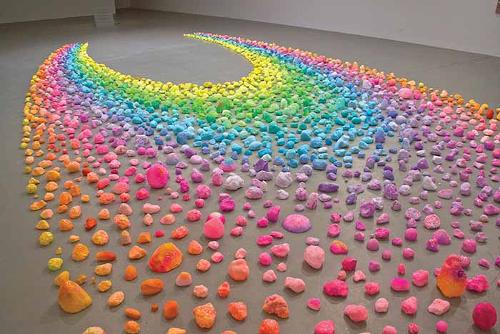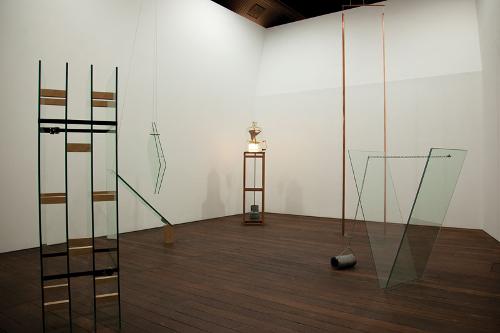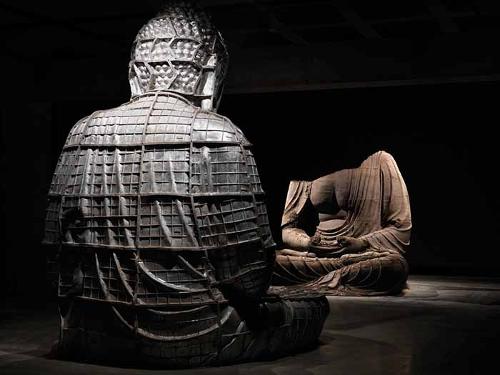.jpg)
Marcel Duchamp's writings on the infra-slim (and his associated concepts infra-thin and infra-mince) are acute observations on the effects of interactions between different materials and energies. The infra-slim is both a perceptual space and a conceptual framework that Duchamp devised to think about the physical essence of a thing through the often invisible, but not imperceptible products of its interaction with another thing. His examples of the infra-slim include such things as the sound of corduroy trousers when someone moves, the warmth of the chair after someone has left it, or the hollow in the paper between the back and the front of a thin piece of paper. Such effects all refer to material states of becoming, but they also reveal something of Duchamp’s keen approach to the problem of perception and how to measure it.
The question of how we can perceive the infra-slim or tap into its particular force preoccupied Duchamp and it has provided a rich framework for Bec Stevens’ recently curated show Hollow in the Paper. Stevens’ selection of works conveyed a number of complex approaches to the infra-slim, both as a field of perception that attends the everyday and a concept that has resonated at particular historical moments in particular artworks and mechanical devices. Whilst there is a temptation with Duchamp’s concept to focus only on the minutiae of life, Stevens’ approach reflected a broad vision that encompassed the micro and the macrocosm, and was rich in both historical allusion and conceptual breadth.
In line with Duchamp, the show traversed surreal and conceptual terrains with some works such as Amanda Davies’ paintings Imagining the infra-slim (2013) or Bleak exercise to grasp the infra-thin (2013), focused on the perceiving subject, and others such as David Haines and Joyce Hinterding’s works on the environmental scale of natural forces. Stevens’ approach highlighted the infra-slim as a "conductor" of energies through the inclusion of mechanical works like the Cloudbusters or the shifting frames and mirrors of (Wo)man with Mirror (2009) the Teaching and Learning Cinema’s reconstruction of Guy Sherwin’s 1976 work Man with Mirror. In subtler ways, Fiona Lee’s and Maria Kunda’s Automatic Conversation Activator (2013) translated the idea of a conductor through a framework of the dialogic game in which players are asked to generate meanings from the sensory perception of unknown objects – an interesting work exploring the infra-slim as a conversational space.
In many works, the slippery effects of the infra-slim were conveyed through layerings, doublings and displacements. The fragmented and out-of-sync recordings of Lee and Kunda’s work or the uncanny doubling of female figures in Pat Brassington’s Sweet Inspirations (2006), alluded to the uncertain effects of unconscious forces. The unexpected material presence of Davies's’ Searching for the Haptic (after "Étants donnés" (2013) re-presented the symbolic door of Duchamp’s enigmatic portal, this time presented not with peep-holes, but with phallic black balloons protruding into the space on a continual loop of inflation and deflation.
All the works in this show are powerful, but at times the installation and limited number of works (which with the exception of Amanda Davies numbered one work per artist/ collaborative pair) felt strained under the weight of the show’s conceptual and historical scope. Although a small number of works can refine a show’s focus, the expansive energy of Duchamp’s concept felt unsupported by the spatial arrangement of the works. In part, this was due to the imposing central position of the Cloudbuster works that tended to dominate the space and undercut the visible animate energies of the others. I wondered whether some adjustments of the gallery space, or even additional smaller-scale works may have allowed for a more energised installation and further insights into the contemporary resonance of the infra-slim – an aspect I felt was under-explored. Such concerns however reveal part of the challenge of framing the infra-slim and perhaps the risk any curator runs in ensuring the gaps in perception to which it refers are not perceived as gaps but, as Stevens proposes, as "generative spaces".












